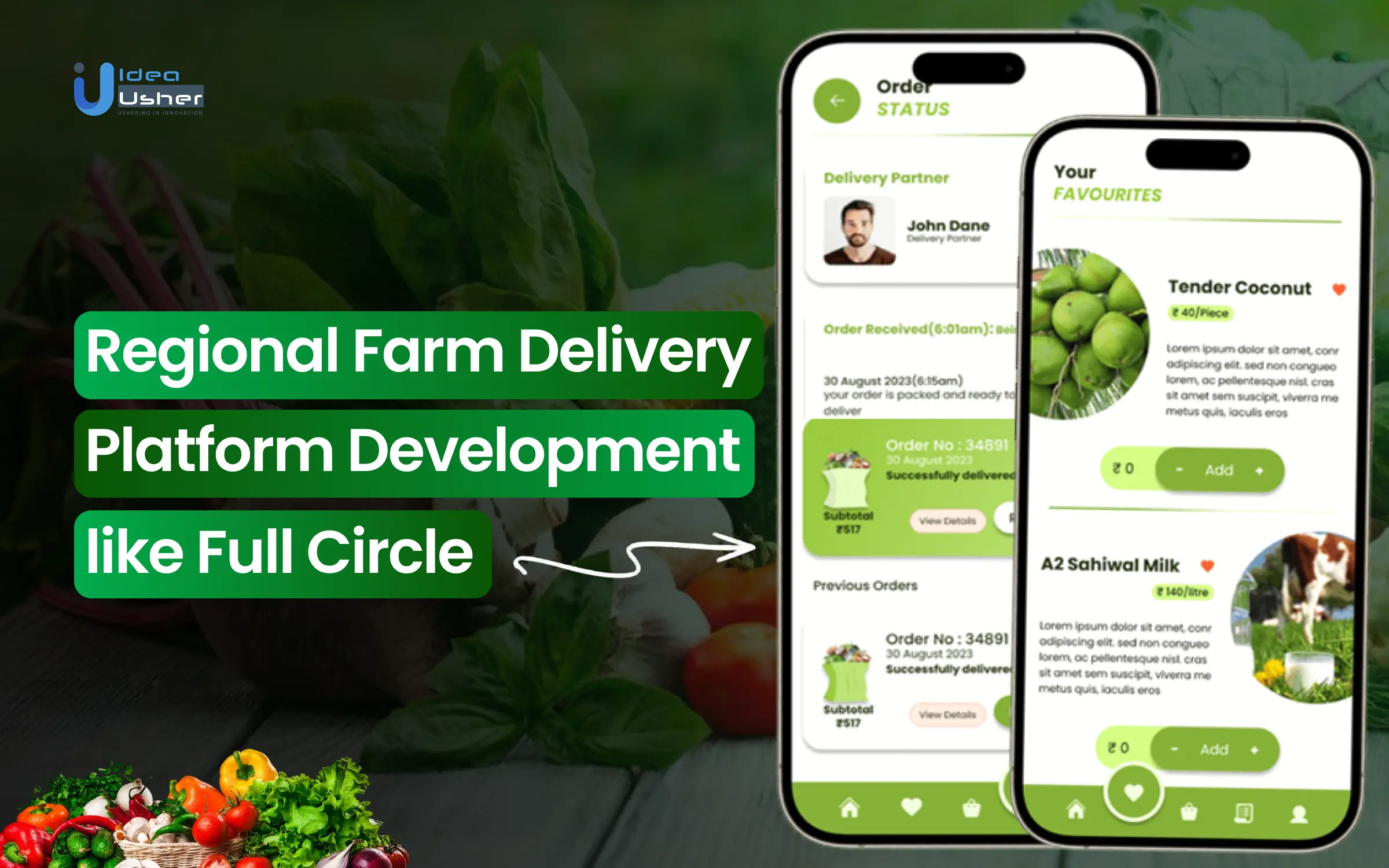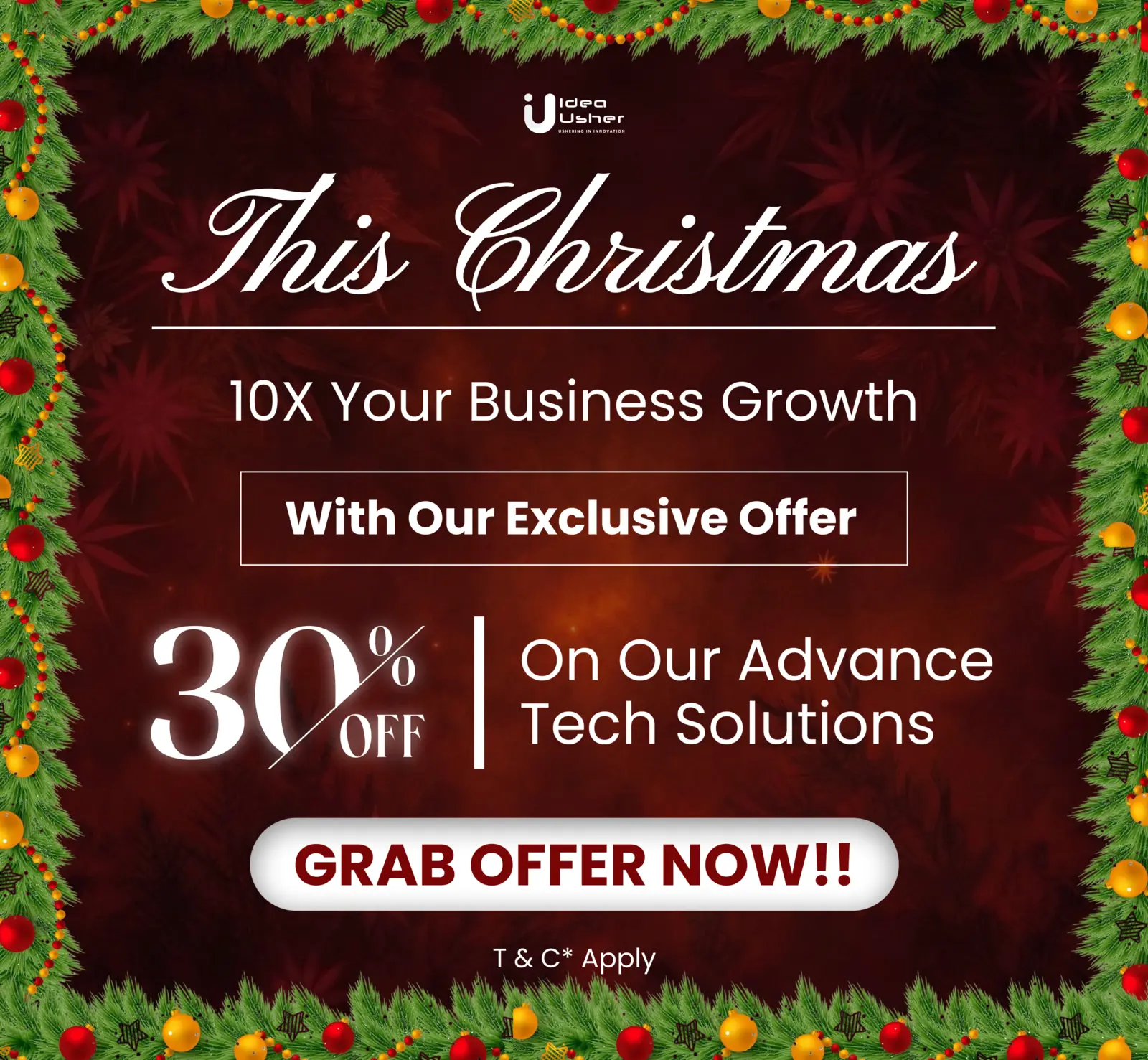Imagine a vibrant regional farm delivery app that serves as a bridge between the best local farmers and customers seeking fresh produce at their doorstep. These innovative platforms facilitate direct connections within the community and empower small-scale farmers by providing them with a fair and sustainable marketplace. This approach fosters a sense of community, as customers not only receive high-quality products but also support local agriculture. Additionally, by reducing the carbon footprint associated with traditional food distribution, these platforms promote a healthier environment for everyone involved.
Full Circle, a regional farm delivery platform, shows how technology can transform the way people connect with local agriculture. This blog explores the process of developing a platform like Full Circle, delving into the necessary features, technologies, and costs, including a subscription management system, a delivery management system, payment processing, and farm management systems.
Key Market Takeaways Of Farm Delivery Platforms
According to Grand View Research, the global online grocery market was valued at USD 50.28 billion in 2022 and is anticipated to grow at a CAGR of 26.8% from 2023 to 2030. Farm-to-door services will drive a significant share of this growth.
Source: GrandViewResearch
In the U.S., about 46% of consumers are willing to pay more for sustainably sourced food, and more than 50% express a preference for organic food. The farm-to-table movement has evolved into the farm-to-door model, which is particularly appealing due to its convenience and sustainability. Research indicates that the subscription box market, including farm delivery services, is growing at an annual rate of 20%.
Consumer demand for local, organic, and sustainable food is at an all-time high, with organic food sales in the U.S. reaching $56 billion in 2020, accounting for approximately 5.8% of total food sales. Studies show that 67% of consumers are more likely to purchase local food products if they are available through convenient delivery options. Additionally, 80% of consumers believe that buying local food supports the local economy, making farm delivery platforms an ideal solution for meeting these preferences. This shift in consumer behavior aligns with the increased interest in sustainable agriculture, further driving the growth of regional farm delivery services.
Work with Ex-MAANG developers to build next-gen apps schedule your consultation now
Overview Of Regional Farm Delivery Platform
Regional farm delivery platforms are transforming how consumers access fresh, locally sourced food by bridging the gap between small-scale farmers and households. These platforms offer a convenient way to enjoy farm-fresh produce, dairy, meat, and other goods, often delivered directly to customers’ homes. By emphasizing sustainability, reducing food miles, and supporting local economies, they cater to the growing demand for healthy, ethical, and environmentally conscious food choices. With features like subscription-based models, seasonal offerings, and customization options, these platforms make it easier for individuals and families to embrace a farm-to-table lifestyle without the hassle of visiting farmers’ markets or specialty stores.
How Does Full Circle Work?
Full Circle, a regional farm delivery platform in the Pacific Northwest, offers a subscription-based service that connects consumers with local farms and artisans. Customers receive curated boxes filled with seasonal produce and locally sourced goods like dairy, meat, eggs, and pantry staples. By prioritizing sustainable farming practices and offering customizable delivery options, Full Circle ensures freshness, convenience, and variety for its subscribers.
Here’s how the process works:
- Sign-Up and Subscription Selection: Customers begin by creating an account on Full Circle’s platform and choosing a subscription plan that best suits their household needs. Options typically include weekly or bi-weekly deliveries, along with various box sizes to accommodate different family sizes or preferences.
- Customization and Add-Ons: While the base subscription includes a curated selection of seasonal produce, customers can customize their boxes to include additional items like dairy, meat, eggs, baked goods, or pantry staples. This flexibility allows subscribers to tailor their orders to match their dietary preferences and lifestyles.
- Sourcing and Packing: Full Circle partners with local farms and artisans that prioritize sustainable practices. Once the orders are placed, the team works to pack boxes with the freshest, in-season produce and goods, ensuring that customers receive high-quality items.
- Home Delivery: The curated boxes are delivered directly to the customer’s doorstep on a predetermined schedule. This eliminates the need for grocery shopping or trips to farmers’ markets, offering unmatched convenience for busy individuals and families.
- Ongoing Engagement: Full Circle also fosters a sense of community through newsletters, recipe ideas, and stories about the farms they partner with. This engagement strengthens the connection between customers and the local agricultural community.
Must-Have Features in a Regional Farm Delivery Platform Like Full Circle
To develop a platform like Full Circle, it’s essential to focus on features that prioritize user convenience, transparency, and a strong connection with local farmers. Here are the key features that will ensure a seamless and engaging farm-to-table experience:
1. Subscription Management
Enable users to subscribe to weekly or bi-weekly delivery plans with flexible options. Offer multiple box sizes and allow users to pause, skip, or modify subscriptions effortlessly. Full Circle offers various box sizes, allowing customers to choose plans that match their household needs, and provides options to pause, skip, or modify deliveries directly through their app.
2. Customizable Orders
Users can personalize their boxes by adding or swapping items such as dairy, meat, or pantry staples. Seasonal recommendations are highlighted to encourage users to explore new products. Full Circle allows customers to customize their orders before the delivery deadline, ensuring they get what they want each week.
3. Seasonal and Fresh Produce Listings
Showcase a dynamic, up-to-date inventory that reflects seasonal availability. Emphasize product freshness and share details about the farms supplying the produce. Full Circle highlights seasonal produce and fresh additions, emphasizing the farm-to-table freshness in their online store and weekly delivery boxes.
4. Farm and Product Information
Feature comprehensive profiles of partner farms, including their locations, farming practices, and specialties. Share sustainability certifications and farm-to-table stories to build trust. Full Circle shares details about their farm partners, including sustainability certifications and stories about the farmers who grow the produce, building trust with customers.
5. Flexible Delivery Options
Allow customers to select delivery days and times that suit their schedules. Include real-time delivery tracking for added transparency and reliability. Full Circle provides flexible delivery options, letting users choose their preferred days and track their orders in real-time for added convenience.
6. Recipe and Meal Planning Suggestions
Inspire customers with recipes and meal ideas tailored to their box contents. Offer features for saving recipes and generating shopping lists for complementary ingredients. Full Circle includes weekly recipe suggestions and meal-planning tips, helping customers use their fresh produce creatively and effectively.
7. Secure Payment Gateways
Support diverse payment methods, including credit cards, digital wallets, and auto-pay for subscriptions. Ensure a seamless and secure checkout experience. Full Circle ensures secure transactions with a reliable payment gateway and provides options for recurring subscription payments.
Why Is Developing A Regional Farm Delivery Platform Like Full Circle?
Developing a regional farm delivery platform like Full Circle is a strategic investment fueled by the increasing demand for fresh, sustainable, and locally sourced food. As consumers become more health-conscious and environmentally aware, platforms that connect them directly with local farms offer a convenient and eco-friendly solution. With the rise of e-commerce and subscription-based services, regional farm delivery platforms are well-positioned to meet these growing consumer preferences, offering recurring revenue opportunities and scalable growth.
Full Circle and similar platforms have demonstrated significant profitability in the regional farm delivery space. For example, Full Circle generates revenue through its subscription model, with customers paying for weekly or bi-weekly deliveries of fresh, seasonal produce and premium add-ons. Platforms like Farm Fresh to You report annual revenues of over $50 million, while Imperfect Foods has reached revenue exceeding $250 million in 2021, highlighting the strong financial potential in this market. Misfits Market, valued at over $1 billion, has raised $200 million in funding, further proving the scalability and success of farm-to-door services.
In conclusion, now is the perfect time to invest in developing a regional farm delivery platform. With rising consumer demand for convenience and sustainability, proven revenue models, and the ability to scale, such platforms offer a significant business opportunity. By tapping into these market trends and leveraging the right technology, you can create a profitable, long-lasting service that meets the needs of modern consumers while supporting local economies and farmers.
How Does Full Circle Make Money?
Full Circle generates revenue through a diverse model that combines subscriptions, product sales, and partnerships with local producers. Here’s a breakdown of their key revenue streams:
1. Subscription Plans
Full Circle’s primary income source is its subscription-based model, where customers pay recurring fees for weekly or bi-weekly deliveries. With multiple tiers based on box sizes and delivery frequencies, the platform caters to various household needs and budgets.
2. Product Markups
Partnering with local farms and artisans, Full Circle applies markups to its fresh produce and specialty goods. Premium items like organic meats or gourmet staples often have higher markups, which cover operational costs and boost profits.
3. Customization Fees
Customers can personalize their boxes by adding or swapping items, often for an additional fee. This not only enhances user satisfaction but also increases revenue through upselling premium or non-standard products.
4. Delivery Fees
While most subscription plans include free delivery, Full Circle may charge fees for certain delivery locations, one-time orders, or expedited services. These charges contribute to operational cost recovery and additional income.
5. Partnerships and Collaborations
Full Circle collaborates with local producers, earning a share of revenue from the sale of their goods. These partnerships expand their offerings and provide a reliable revenue stream from high-demand items.
Steps to Develop A Regional Farm Delivery Platform Like Full Circle
Developing a regional farm delivery platform like Full Circle is about creating a system that connects communities to fresh, local produce. The process requires strategic planning, user-friendly design, and a commitment to supporting farmers and sustainable practices.
Step 1: Conduct Market Research and Define Target Audience
Start by analyzing the market for regional farm delivery services, identifying trends, customer preferences, and competitor offerings. Then, understand the needs of farmers and consumers in your target region to create a platform that effectively bridges the gap.
Step 2: Create a Comprehensive Business Model
Define your platform’s unique value proposition, revenue model, and key features. Decide whether you’ll focus on subscriptions, one-time purchases, or a hybrid model. Include logistics planning and partnerships with local farms and artisans in your strategy.
Step 3: Design a User-Centric UI/UX
Develop an intuitive and visually appealing design for your app and website. Ensure ease of navigation, clear product displays, and seamless access to features like subscription management, product customization, and order tracking.
Step 4: Build Core Functionalities
Develop essential features, including subscription management, seasonal product listings, secure payment gateways, and customizable orders. For example, allow users to choose box sizes and add extras like eggs or meat to their orders.
Step 5: Integrate Advanced Features
Incorporate advanced features to enhance functionality and user experience. Use machine learning to recommend products based on users’ past orders and preferences. Provide customers with accurate delivery status updates, boosting transparency and reliability.
Step 6: Implement Farmer and Supplier Portals
Develop a dedicated interface for farmers and suppliers to manage inventory, update product availability, and track orders. This ensures efficient operations and accurate product listings.
Step 7: Conduct Rigorous Testing
Extensive testing of your platform across devices is performed to ensure smooth performance and eliminate bugs. Test all functionalities, including subscription flows, order customizations, and payment processing, to deliver a flawless user experience.
Step 8: Launch and Promote the Platform
Once your platform is ready, launch it in your target region and promote it using digital marketing strategies. To attract eco-conscious consumers, highlight your commitment to sustainability and local sourcing. Use promotional offers and partnerships with local influencers or farms to build initial traction.
Cost Of Developing A Regional Farm Delivery Platform Like Full Circle
| Phase | Details | Estimated Cost (USD) |
| Research and Planning | Market analysis, business planning, and feature specification. | $2,000 – $6,000 |
| Design and UI/UX | Wireframes, UI/UX design, and prototyping. | $4,000 – $10,000 |
| Front-End Development | Website and mobile apps (native or cross-platform). | $6,000 – $18,000 |
| Back-End Development | Server-side logic, APIs, and database setup. | $5,000 – $15,000 |
| Key Features | User accounts, product catalog, checkout, delivery, etc. | $8,000 – $25,000 |
| Testing and QA | Functional, usability, performance, and security tests. | $3,000 – $8,000 |
| Deployment and Maintenance | Hosting setup and ongoing updates/support. | $2,000 – $6,000 |
| Total Estimated Cost | $10,000 – $100,000 | |
Factors Affecting Cost Of Developing A Regional Farm Delivery Platform Like Full Circle
- Scale of Operations: Platforms serving larger regions require more complex logistics systems, increasing development and operational costs. Small-scale platforms can focus on limited regions, keeping costs manageable.
- Level of Customization: Highly tailored features, such as personalized subscription plans or interactive farm profiles, raise costs. Standardized features or templates can reduce expenses.
- Integration with Local Farms: The number and diversity of farm partners influence the complexity of vendor management systems. Integration with existing farm management software adds to development time and cost.
- Real-Time Features: Live inventory updates, delivery tracking, and geolocation features require advanced technology and raise costs. Static or less dynamic platforms reduce the need for real-time integrations.
Conclusion
The future of regional farm delivery platforms is bright, fueled by growing consumer demand for fresh, sustainable, and locally sourced produce. With advancements in technology and an increasing emphasis on ethical consumption, these platforms are well-positioned to transform the agricultural supply chain. Now is the perfect time to invest in developing a platform like Full Circle, as it aligns with market trends such as the shift toward e-commerce, the rise of farm-to-table movements, and the growing awareness of environmental sustainability. By leveraging innovative technologies and prioritizing user-centric designs, businesses can tap into this burgeoning market, fostering stronger connections between local farmers and communities while driving long-term growth and impact.
Looking To Develop A Regional Farm Delivery Platform Like Full Circle?
At Idea Usher, we are committed to transforming your vision into reality with unparalleled expertise and dedication. With over 500,000 hours of coding experience in app development, we have the proven capabilities to build a powerful, scalable, and feature-rich regional farm delivery platform like Full Circle. Our team of experts will guide you through every stage of development, ensuring your platform integrates seamless subscription management, real-time order tracking, personalized recommendations, and sustainable logistics. We build solutions that drive growth, foster community connections, and revolutionize the way consumers access local, fresh food.
Partner with us for a flawless, future-proof platform that will set your business apart and empower you to succeed in the fast-evolving farm-to-door market.
Work with Ex-MAANG developers to build next-gen apps schedule your consultation now
FAQs
1. What technologies are used in developing a regional farm delivery platform?
The platform typically uses technologies such as cloud computing (AWS, Google Cloud), mobile development frameworks (React Native, Flutter), AI/ML for personalization, API integrations, and blockchain for transparent supply chains. Additionally, databases like MySQL or MongoDB manage user and product data.
2. How can I ensure my platform is scalable?
To ensure scalability, use cloud-based infrastructure, modular development, and microservices architecture. This allows you to easily scale your platform as user demand grows easily, ensuring consistent performance without disruptions.
3. How do I attract local farmers to partner with my platform?
Offer farmers a user-friendly portal for managing inventory and orders, ensure fair compensation, and promote transparency in product sourcing. Additionally, emphasize the marketing opportunities for farmers and the potential for direct connections with consumers who value locally grown, sustainable products.
4. What is the revenue model for a regional farm delivery platform?
Common revenue models include subscription fees, product markups, delivery charges, and add-on customization fees. You may also generate revenue through partnerships with local farms and artisan businesses, seasonal promotions, and premium offerings.






















